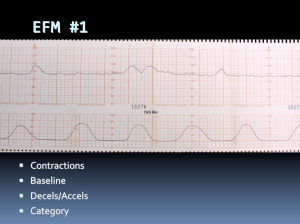EFM is ubiquitous in it’s presence throughout the Labor and Delivery world.
It has proven useful in documenting contraction patterns, fetal well-being, and fetal response to stress. We teach it’s interpretation to all of our students who will be providing care to women in labor.
As this is an introductory lecture, it assumes no previous knowledge of the topic, but does assume a basic understanding of anatomy and physiology.
Whenever I’m teaching this topic, I start with having the students simply watch the video. I reassure them that the video is fast-paced and they may not get everything on the first pass. They shouldn’t be worried, though, since we’ll go over everything in the group session that follows, and they can always go back and access the video online (at obgynmorningrounds.com).
The video is 18 minutes in duration (a little long, I think, but there’s a lot of material to cover). After the video, I have an audience participation PowerPoint presentation. Each PowerPoint slide is a picture of 20 minutes of a particular tracing.

With each slide, I ask one student to interpret the tracing. I explain that interpretation takes some practice, and the first several people won’t likely do a very good job, but that’s part of the learning curve.
To help the students learn (and embed this concept in them), I always show the four parts of interpretation underneath each strip (Contractions, Baseline and Variability, Accels/Decels, and Category).
As they give their interpretation, they are forced to follow that 4-part guide, and for many of them, it is the forcing of them to speak in that way that locks in this concept.
I correct every mistake, and then move to the next strip, asking a different student to interpret the new strip. Again, I correct each mistake, and then move on.
There are 13 strips. By the 4th strip, the students are into the rhythm of interpretation, and getting most everything right. By the 8th strip, I’m moving into more rare conditions. By the 13th strip, they all are up to speed on how to interpret the monitor strip, being sure to include each of the 4 components.
At the end of the lecture, I give each student a Status Check, a two-page written test, covering the material I’ve just presented. This is mostly for their own benefit, as their score does not count toward anything. The students grade their own tests, but they do need to turn them in, so I can see how they did. If one student did poorly, they need some extra help. If many students did poorly, then I need to revise my teaching.
Video Lecture
PowerPoint Review
- Electronic Fetal Monitoring Review (.pptx – 39 MB)
- Electronic Fetal Monitoring Review (.pdf – 43 MB)
- Electronic Fetal Monitoring Review (.pdf – 44 MB)
- EFM Answer Key (.pdf – 81 kb)
- Status Check
Guideline for Fetal Monitoring in Labor and Delivery
- NNEPQIN December 2012 (.pdf – 0.3 MB)
